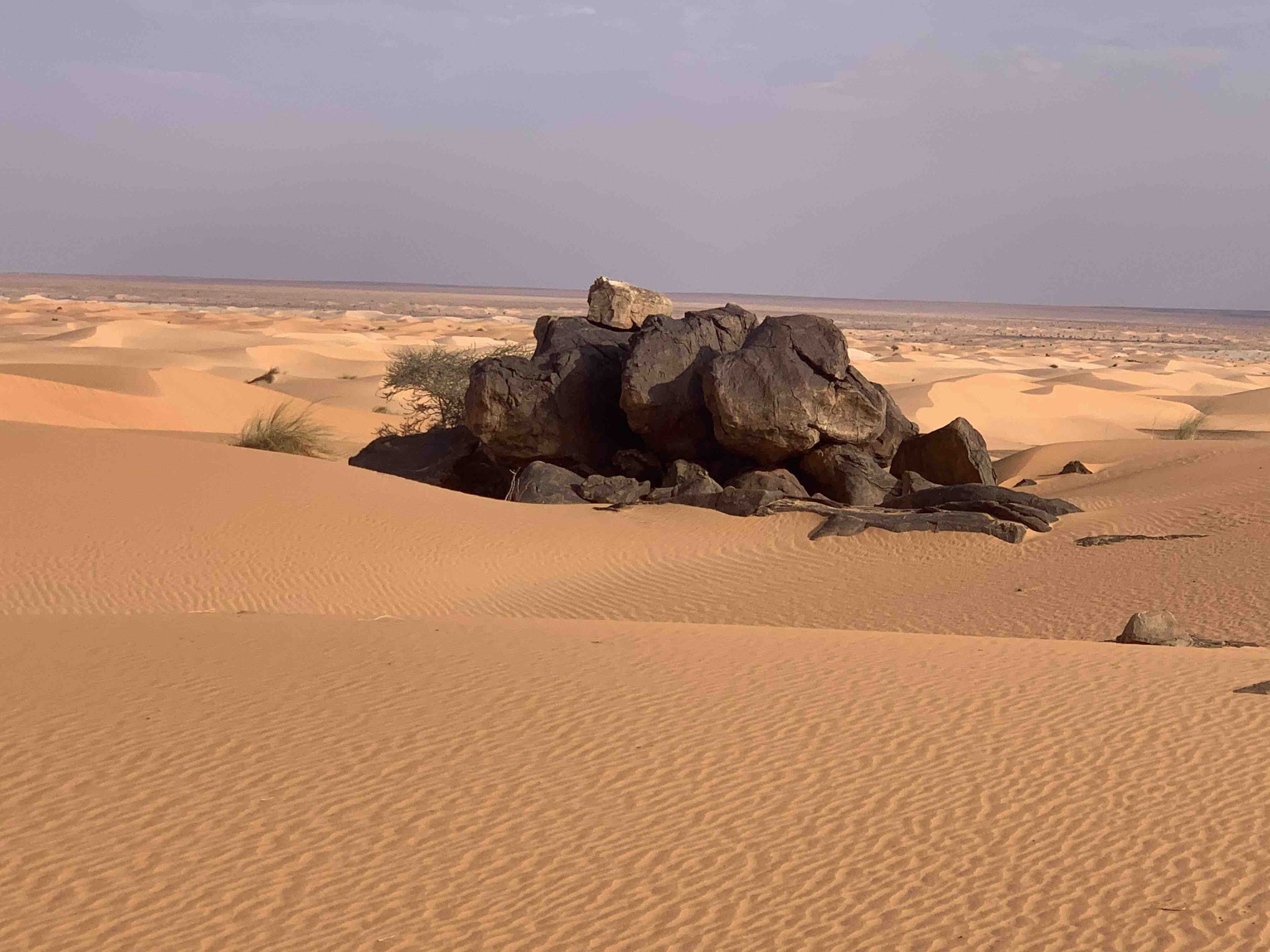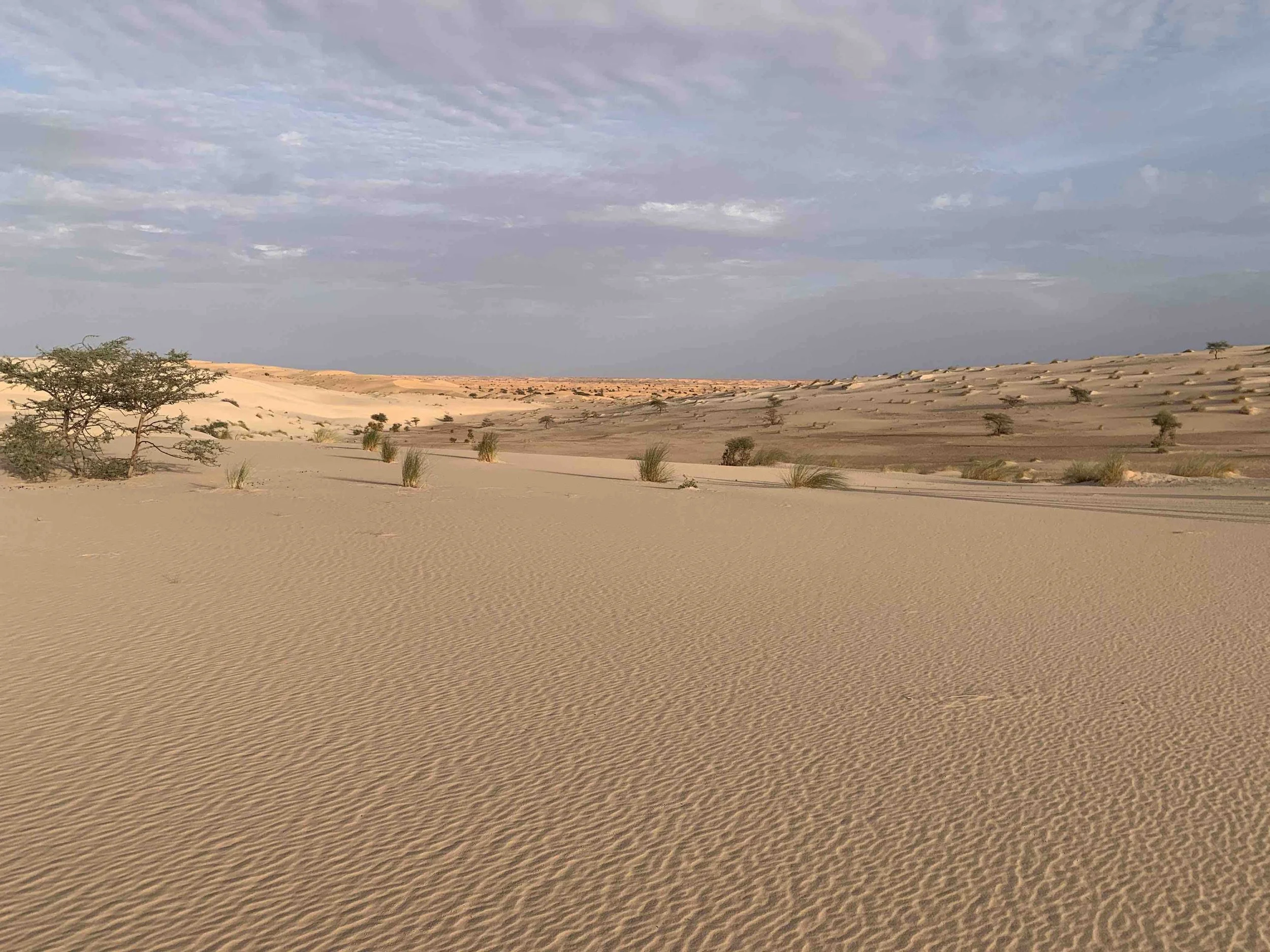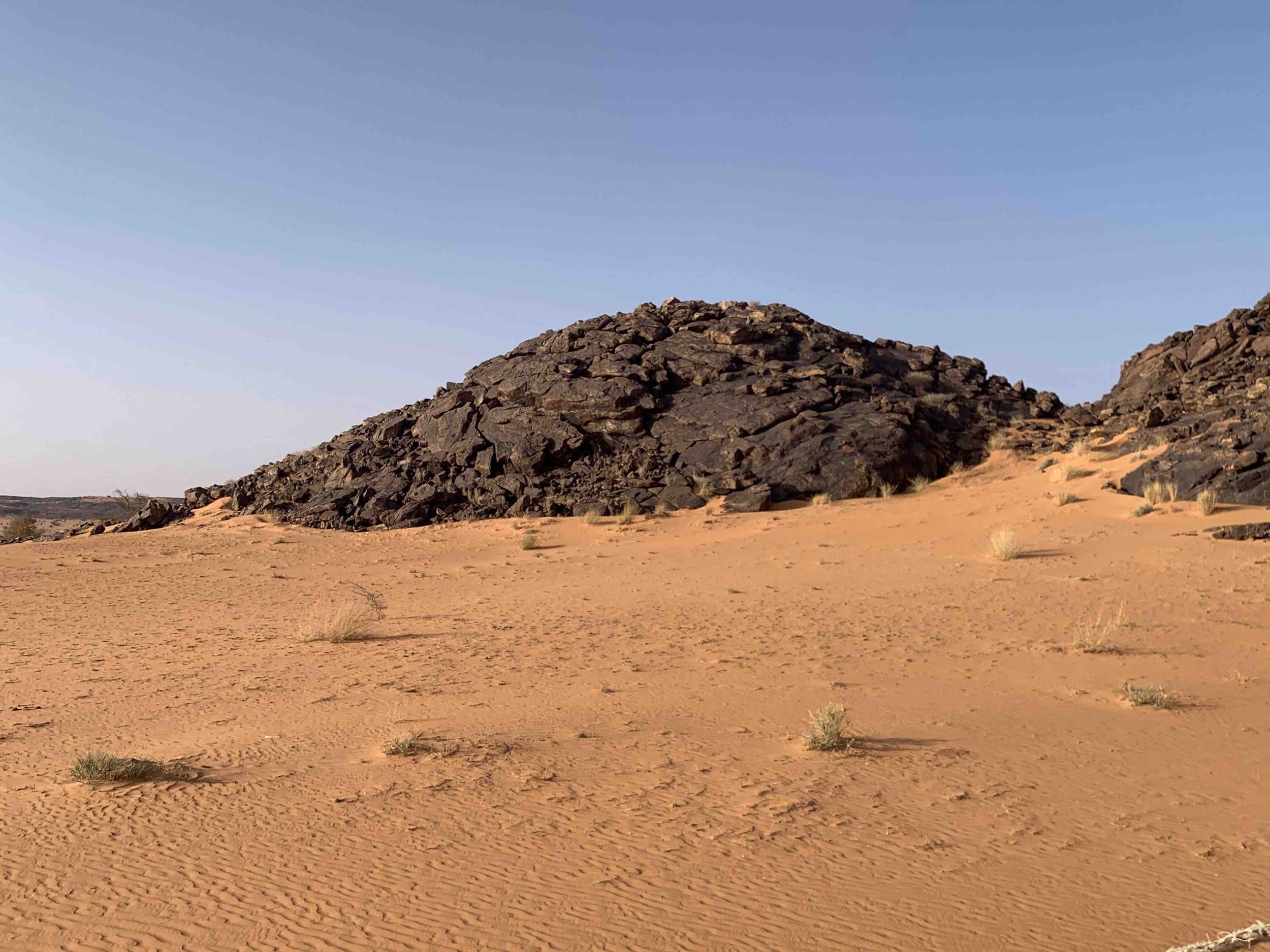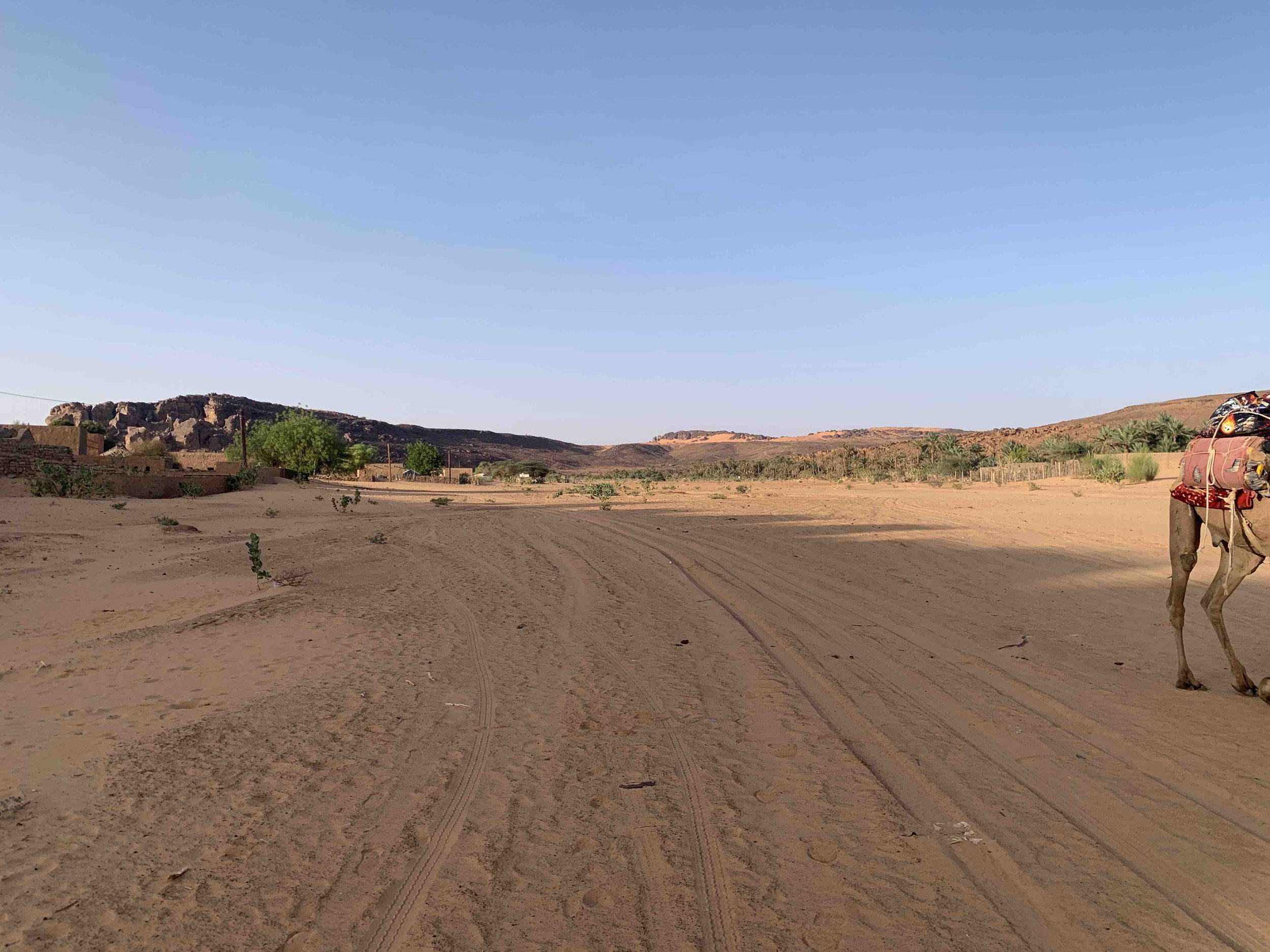qafila khamisa
journal: days 09-11
JOURNAL
3. journal: days 09-11
DAY 09
31.10.2021
4h45 / 19.01 km







Yesterday evening 2 young people came to see us. They worked in the garden next door. One from Chinguetti, the other from this area. They had tea with us and then they left.
I thought we were going to have problems with the bugs (lots of ants, beetles, white ants), 2 mices that keep looking and rummaging through our luggage. But in the end I didn't get bites. In addition, we had a “Dama de Noche” shrub (night gallant or night jasmine), not yet in bloom but we could smell it.
Regarding animals, we must not forget the couple of crows. Are they the same since day 1? Nefaa explained to me that they follow the camels because they eat the tics, they even manage to land on them to eat them and the camels let themselves be.
I told Nefaa he had to buy a shotgun because we could have hunted more rabbits. When we got to the camp, there was one who ran out just in front of us.
In the morning I finally understood that the mountain Nefaa was telling me about is further away. On Google Maps I saw an erg that without the shadows looked like a mountain. As we left, we turned to the southeast where there was a well not far away.
There was a girl taking water when we arrived and she left her place for us. Built with stones, the water was only 1.5m away. 10 minutes later, a father and his son came to see us (also to give drink to his goats). It was a family that lived in a khaïma (nomad tent) 500 m away. Then we saw another khaïma. According to Nefaa, they were not nomads, they just used to move a few km depending on the rain.
At the 4th khaïma, he told me if I wanted to stop by and say hello to them and I said why not. It was a tent next to a small isolated dune. There was no one. While walking on the edge of the dune, another tent appeared just across the dune. There were two women with 4 little girls there. Quickly they offered us tea, but finally the "grandmother" made us something to drink, goat's milk with water and sugar. I drank a little bit and it was good, very good. 10 minutes later, a young woman arrived, she must have been a friend of the girl's because they hugged each other warmly. They all spoke in Hassanya and I understood nothing. Inside the tent, only rugs and all the things on the sidelines. Outside, all the kitchen tools.
The men were not there, surely they were with the animals elsewhere.
Our visit was unexpected but the way of dressing of the woman (around 40s) was on one side very elegant, black for the fabric of the body, dark blue for that of the head. But when she moved to prepare us milk and that she put the cloth on her head several times, you could see how the black cloth was a little transparent and let her breasts be seen (without a bra *). She felt very comfortable, maybe because her husband was not there...
*normally they use a very tight t-shirt spell.
They were from the same tribe as Nefaa, Aoudafil (Chinguetti). Before leaving I asked about the extent of the territory where they could settle. It wasn't like Nefaa told me, they were really nomads who moved between Chinguetti and Tichitt, depending on the rain.
We continued on our way and saw a 5th tent. As we approached Tagant region, the nomads began to increase in number.
After the erg (pebble ground) we crossed a dry wadi (river) but on one of the edges we saw tumuli. It will be good to seek more information.
To end the morning, more dunes. After only 12 km, Nefaa decided to settle us between dunes and two talha shrubs. He confessed to me that he was tired (he is not sleeping well from the cough caused by the tobacco) but so am I.
We hope to arrive at the great wadi which precedes the mountain and that will bring us the day after tomorrow to Rachid.
To get to the river you had to go through dunes, but I did not expect this geography at all. Suddenly we divided up a space of about 20 km between 2 dunes mountains. Below, the river which also forms the boundary between the Adrar and Tagant. But what a space! As if we were entering another dimension, with different physical parameters and not only because of the colours of the sand (up to 4), but also by their shapes. Plus, it’s as if the sand were much heavier than the large boulders clustered on the ridges of the dunes, boulders that looked like the remains of prehistoric animals.
The pace was too slow, but we finally arrived at the river.
DAY 10
01.11.2021
5h42 / 24,77 km




Nefaa drew me a drawing on the sand to explain to me the terrain. We were already in the river and this morning we were going to walk a path that could be described as a nomadic route. Hard sand, sometimes solidified and with talhas and taichots on the edges. We went to say hello to another khaïma, where only 2 children and a woman were getting ready to fetch water, loading cans (like ours) onto a donkey. She was from the Akalal tribe, that is to say, from Chinguetti.
During a break to drink water, Nefaa told me he was hot. From the start, without wind, with the sun in front and with the white sand, it was difficult to walk, especially when the sand was not hard. I also had something wrong every now and then, I lost my balance. Was it the sun, the fatigue...? Was I ill? At one point I thought I was going to fall, except I could figure out what was happening. On the dunes the feet can sink into the sand, normally vertically, but in this part, one foot could also move sideways and the other in the other direction (in fact each foot could move in several directions with each step), it was not my head that was not keeping balance, but my feet as I walked on unstable ground.
The best thing was to be able to walk on solidified sand (sometimes it gave rise to mini models of a geography, with its contour lines). This ground allowed me to walk at 12’ per km. At the end of this road and before taking the mountain which will bring us tomorrow to Rachid, we stopped for lunch and a local nomad ate with us. He had got his things right next door, but he didn't have a tent, would it be the one we saw 300m before? The owner of the latter visited us too. He is not from Chinguetti but from a local tribe. He kept mocking the other one saying "as-sudani", that in fact is from the Akalal tribe of Chinguetti.
Finally the man who came first had his tent 300m down the route, a tent without the side fabrics, I guess for the warmth. According to Nefaa, maybe it was 35-36ºC.
The start was complicated because of the heat, the sand (not too firm) and the pace of Nefaa. I couldn't follow him. Besides, I thought we were about to cross the mountain, but the “nomadic route” did not end. After 5 km there was a well in the middle of the river. It was funny because the animals, donkeys and camels, were waiting in the shade of the trees, as soon as they saw us heading towards the well, all of them quietly approached. On the other hand, after giving our camels to drink and filling 2 small cans, there was no concrete or metal container to leave water. Thus, the animals had to show who was stronger to drink what was left on the ground...
We walked till the asphalt, as the two roads came together to cross the mountain. Once at the top we stopped to sleep, after almost 25 km.
DAY 11
02.11.2021
4h55 / 22,13 km



Before I fell asleep, something stepped on my chest and right shoulder. It wasn't a beetle because it went too fast. It could have been a lizard but we didn't see them at night, only during the day. Another option would be a little mouse... I was so tired that I didn't care.
The night was strange, very windy, but thanks to the mountain and the tree we had no sand. On the other hand, it was hot and I did not rest well.
In the morning, Nefaa started walking at a very fast pace. He told me the sand was finished, but all day long there was only sand. We left the paved road yesterday and crossed several small mountains, obviously with sand. We were able to climb, in total, up to 200 m, in height, in order to shorten the path of the river (which the road follows). 2h10 later (I was exhausted) we just joined the road and came across a village where women, in a kind of khaïma with concrete pillars, invited us to drink milk. But they also wanted to sell us souvenirs...
For 5 km we followed the road because there was too much sand and also wind, almost headwind. For lunch, Nefaa chose a large talha between the dunes. We were 2 km from Rachid, where we were going to buy food, besides, Nefaa found some telephone network and he could order goat meat that we will eat tonight and tomorrow.
Although the path we did is the most traveled, Nefaa told me there was another further east, a little shorter but more difficult to pass, with too many dunes and stones.
We didn't have to follow the road to get to Rachid, we took the bed of the river and it was better, and shorter. We disembarked, and people were looking at us, especially at the tourist. On the other hand, at 16:15, almost all the shops were closed. Fortunately we found one with fruit (apples, bananas and tangerines). With that and the goat meat we had enough to finish the trip. The little valley of Rachid was beautiful. I was shown the ancient city across the river, but completely abandoned and in ruins. I will have to seek information and come back, because I think it was an important crossing point for caravans, quite controllable dimensions, water, palm trees, talhas… A strategic place only 40km from Tidjikja.
Nefaa decided to settle in just before finishing the little valley on the “banks” of the river, quite calm and beautiful.
Credit videos, pictures, texts and drawings: Carlos Perez Marin
Cameras: iPhone XS Max and Leica M6 (Ilford FPE Plus 125)





















































































































































